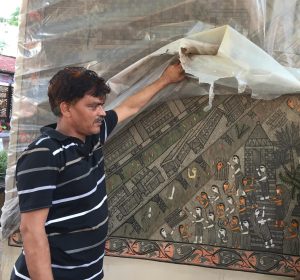On a recent visit to the Crafts Museum in Delhi, I thought again about why tribal paintings tended to portray diverse types of animals, but only one kind of tree or, at least, one that can not be easily identified as one or other species. So I asked about 6-7 of the artists, of whom one, Mr. Ajit Kumar Jha, explained it best.
As I understand it, traditionally specific animals represent particular things (e.g., peacock for love), and there were rules about what went into paintings. For the plant world, it always had to be a kalpavrikhsa, a mythical tree. Therefore, he said, when artists started expanding the scope of their paintings, they tended to keep to that tradition–diverse real animals, and diverse imaginary plants.
When I kept on about how we needed real plants, too, he smiled and went up to his mural, which was under wraps.
It was a mural on climate change and its effects, and Mr. Jha explained it section by section, leading to the section on the effect of pollution on trees, where he had specifically portrayed a neem tree and a peepal tree.
As he explained his mural, he said that he had put all of it together as a coherent story based on stuff he had read or seen or heard about.

